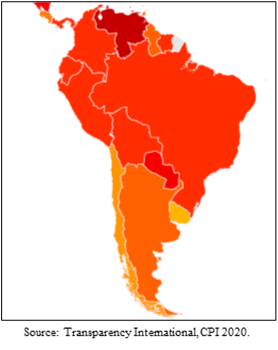International Regulatory Enforcement (PHIRE)
ESG Due Diligence in Latin America under a COVID-19 World
April 15, 2021
Jon Drimmer
Claudia Valdivia, Internet para Todos
and Pablo Gil de Montes, Gryphon Strategies
I. INTRODUCTION
In the halcyon days of February 2020, before COVID-19 took hold across the globe, McKinsey & Company released a survey on the implications of environmental, social and governance (ESG) factors for business and investments. The survey focused on C-suite leaders and investment professionals: those who run, acquire and invest in businesses. Eighty-three percent of those surveyed said they expect that ESG programs will contribute more shareholder value in five years than today. They believe strong ESG performance creates value over the short term and the long term, and that the long-term value of environmental and social programs rivals or exceeds the value of governance programs. They also indicated that they would be willing to pay a 10 percent premium to acquire a company with a positive ESG record over one with a negative record.[i]
Those results are consistent with the individual efforts of institutional investors. In January 2020, Larry Fink, the founder and CEO of BlackRock, the world’s largest asset manager, penned a letter to the chief executives of the world’s largest companies advising them of a shift in BlackRock’s investment strategy. Stating his belief that “we are on the edge of a fundamental reshaping of finance,” Fink announced initiatives “to place sustainability at the center of our investment approach,” emphasizing that “sustainability- and climate-integrated portfolios can provide better risk-adjusted returns to investors.” While emphasizing climate risks and sustainability more generally, every company’s “prospects for growth are inextricable from its ability to operate sustainably and serve its full set of stakeholders,” the letter said.[ii]
The COVID-19 pandemic has further shaken up corporate priorities, and if anything, it will solidify ESG as a priority for companies. Studies consistently demonstrate that ESG funds and businesses with strong ESG records are outperforming others.[iii] Because governance is a “central element of corporate resilience”—and businesses with robust ESG performance have stronger reputations and standing among customers, employees, communities, policymakers and other key stakeholders—they are more likely to retain loyalties and sympathies in times of volatility.
The 10 percent ESG acquisition premium identified in the McKinsey survey, along with Fink’s message on reshaping finance, will become increasingly relevant over the next year. As The Economist concludes, the crisis will “alter the structure of global business.” There will be substantial shifts in investments, and to bolster their market share, stronger companies will acquire those that are foundering, often with the encouragement of government.[iv] Given the short- and long-term risks and opportunities ESG factors can bring, ESG due diligence will have a pronounced role in acquisition and investment decisions—especially during the COVID-19 crisis and as it begins to wane.
Demands for responsible business conduct, and a focus on ESG, have never been more pronounced.
II. UNDERSTANDING THE ESG CONCEPT
ESG refers to environmental, social and governance considerations. Strong ESG performance has become a business imperative, and ESG due diligence now is included in virtually every significant transaction.
Environmental risks typically include: climate change, biodiversity, deforestation, water and air pollution, and life cycle impacts of products are among the issues taken into consideration when conducting ESG due diligence. The Social aspect of ESG due diligence typically looks to identify any human rights violations, such as child labor, forced and compulsory labor, health and safety, freedom of association and right of collective bargaining, health care, remuneration, and working hours. The last piece of the analysis are Governance risk considerations related to corporate practices, business ethics, reputational issues, diversity and lobbying.
In recent years, Latin America has been a focus of confrontation between foreign investments and local, social and environmental expectations. It has become well accepted that eEnvironmental Impact Assessments are not guarantees against potential pitfalls down the road. Mining projects in Peru have had high profile protests, with people yelling “Conga no va!” and former Peruvian president Humala promising “water over gold” in order to get elected. Other mining projects have faced road blockades, which reduces their production capacity. Peru’s environmental issues stem from the over-extraction and pollution of natural resources. Challenged industries include mining, oil and natural gas production, and illegal logging. In general, Latin American countries have lacked serious oversight of these industries. Most LATAM countries have also seen corrupt politicians allow companies into environmentally fragile areas in exchange for bribes, but the situation has changed in recent years, and regulatory agencies have begun to crack down these practices.
V. IDENTIFY THE INHERENT RISKS OF THE LATIN AMERICAN REALITY
ESG due diligence exercises, in LATAM or anywhere else, basically entail 3 components.
 First, gain an understanding relevant country-level risk. These can be identified from various public sources, such as the Corruption Perception Index published by Transparency International, TRACE’s Matrix, and the ESGI (Environmental, Social and Governance Index).[v]
First, gain an understanding relevant country-level risk. These can be identified from various public sources, such as the Corruption Perception Index published by Transparency International, TRACE’s Matrix, and the ESGI (Environmental, Social and Governance Index).[v]
Second, consider the sector itself. Each sector has different inherent risks, which also can be identified from public sources. These might include the Sustainability Accountability Standards Board materiality map, and other such resources.
Finally, consider the company itself. The extent of company-specific diligence can vary widely, from a lighter assessment largely relying on public information—perhaps appropriate for modest investments or a hostile or confidential transaction—to a far more in-depth exercise that includes detailed ESG-specific questions and analyses, and some level of engagement with management. Regardless of whether the diligence is light or involved, the object is the same: to identify the company’s specific risks and opportunities, and to assess the maturity of the company’s approach to addressing them.
In turn, that final component generally involves a three-part inquiry: (1) identify the extent to which the company has assessed and responded to its salient ESG risks and opportunities, (2) gain insight into a target company’s commitment to ESG and its overall risk appetite, and (3) understand how the company manages issues when they arise. While different approaches can be undertaken to accomplish these three steps, the goal will largely remain the same.
CONCLUSION
The pace of ESG as a global business imperative has increased dramatically during COVID. However, a “one size fits all” approach to ESG due diligence throughout LATAM will not work. The diverse cultures and histories of each country in the region must be taken into account, along with the unique aspects of each company and operation. That said, whether it is human rights, business ethics, or climate change, internal and external stakeholders are demanding that businesses in and outside of LATAM operate in a manner that is responsible and socially aware. Those businesses that respond to these demands will thrive; those that do not run the risk of being left behind. Remember, ESG due diligence in Latin America must consider a customized approach, evaluating and mitigating the relevant risks in every market, country and company.
[i] “‘The ESG Premium,’ New Perspectives on Value and Performance,” McKinsey, Feb. 2020.
[ii] Letter from Larry Fink, “A Fundamental Reshaping of Finance,” January 14, 2020, at https://www.blackrock.com/corporate/investor-relations/larry-fink-ceo-letter.
[iii] Oliver Schutzmann, “ESG Storks Prove Their Value During COVID-19 Crisis,” IR Magazine (April 3, 2020), at https://www.irmagazine.com/esg/esg-stocks-prove-their-value-during-covid-19-crisis; Ashim Paun, “ESG Stocks Did Best In COVID-19 Slump,” HSBC (March 27, 2020), at https://www.gbm.hsbc.com/insights/global-research/esg-stocks-did-best-in-corona-slump?_lrsc=ccb36746-1bbe-4d98-85db-0c3bfa89806c; Madison Darbyshire, “ESG Funds Continue to Outperform Wider Market,” Financial Times (April 3, 2020), at https://www.ft.com/content/46bb05a9-23b2-4958-888a-c3e614d75199; David Stevenson, “Are ESG and Sustainability the new Alpha Mantra,” Financial Times (April 1, 2020), at https://www.ft.com/content/6cee0b48-7760-46a5-9759-243aaaff7f8a.
[iv] “Pandemic Shock Will Make Big, Mighty Firms Even Mightier,” Economist (March 26, 2020), at https://www.economist.com/business/2020/03/26/the-pandemic-shock-will-make-big-powerful-firms-even-mightier.
[v] ESGI metrics, available at: https://risk-indexes.com/about-esgi/
Contributors

For More Information
